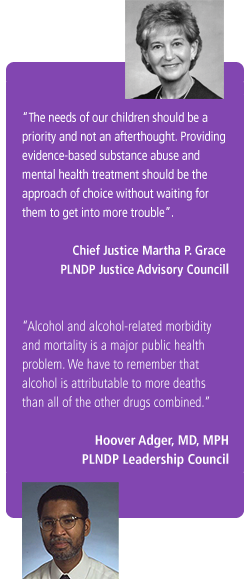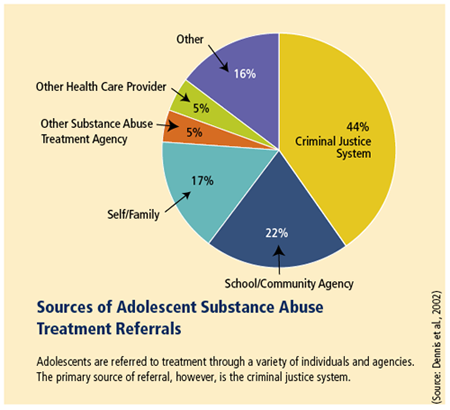
 Adolescent substance abuse is a major national public health problem. While recent studies show a slight decrease in the age of adolescents who drink alcohol and use illicit drugs, the prevalence remains too high.
Adolescent substance abuse is a major national public health problem. While recent studies show a slight decrease in the age of adolescents who drink alcohol and use illicit drugs, the prevalence remains too high.
Most recent data show continuing problems with heavy drinking among adolescents with 25.9% of twelfth graders having 5 or more in a row in the last two weeks (Johnston et al., 2007).

Adolescence is a period during which impulsive and risk-taking behaviors are more pervasive. Compared to adults, adolescents tend to experience more problems with alcohol and marijuana, higher rates of episodic/heavy use, and greater complications as a result of the developmental changes they are undergoing (Dennis, 2002). Adolescents involved in the juvenile justice system are considerably more likely to have substance use problems than adolescents in the general population. More than two million youth are charged with delinquency offenses and enter into the juvenile justice system each year and of those 62.5% report alcohol and other drug problems (National Institute of Justice, 2003), while 75% also report mental health problems (Drug Strategies, 2005). Many of these individuals also have other problems that may influence their delinquent behavior and their use of substances.
Many youth with substance use problems in the juvenile justice system do not meet clinical criteria for substance use disorders or dependence. The process of developing problems is influenced by many factors such as genetics; societal, familial, and peer influences; pre-existing mental health disorders; and the addictive properties of the specific substance (Dembo et al., 1993). It is very important to assess the level and severity of an adolescent’s problem and utilize interventions targeting their unique needs. However, availability of treatment is a serious problem in the juvenile justice system with fewer than 3% of adolescents in the justice system that need treatment receiving it. (CASA, 2004). Those who are fortunate to receive treatment rarely receive adequate treatment.
Five Things to Know About Adolescents’ Brain Development and Drug Use
- The brain’s “front end,” the part above the eyes, is responsible for slowing us down or stopping our impulsive behaviors. This region considers the risks and benefits of our actions, and it helps us “hit the brakes” when we consider doing things that are too risky.
- This frontal part of the brain is still developing connections to the rest of the brain until adulthood, so adolescents' brains lack some of the “wiring” that carries “brake” or “stop” messages to the rest of the brain.
- Drugs of abuse are often available to adolescents. These drugs feel good, but they can be very harmful. Lacking some of the wiring for the “stop” message, adolescents’ brains may not be capable of fully weighing the risks of drug use.
- The two drugs that cause the most death among adolescents are also the most available drugs: tobacco and alcohol. Late adolescence, before the brain is fully matured, is the peak time for developing dependence on these (and other) drugs.
- Heavy drug use during times of critical brain development may cause permanent changes in the way the brain works and responds to rewards and consequences. Therefore, it is important to begin to address a developing substance use problem as early as possible.









